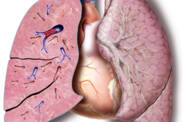Life-threatening diseases and First Hour Quintet

Thrombosis: A disease of the old? It threatens the young too + Causes and manifestations
Vascular thrombosis is a disease or condition that represents a serious medical and social problem. It affects mostly adults, less often adolescents, and children are no exception.

What is life like after a heart attack? Does it limit, cause incapacity for work?
Diseases bring with them various limitations, and not only during their duration. Some diseases and conditions require a permanent change in lifestyle. Myocardial infarction is one of these conditions. Just because someone has overcome it does not mean that they will continue to live as they have been living. The aim is to prevent a recurrence of the disease, which is more likely with each successive heart attack in life. It is therefore necessary to change some habits or bad habits that may have been established.

Diagnosis called heart attack: what is the treatment and referral of the patient?
The pre-hospital phase of a sudden-onset heart attack forms an extremely important part of the overall treatment process of the affected person. However, the treatment and referral of the patient to the appropriate medical facility depends on several factors.

How to detect a stroke early?
Stroke, cerebral infarction, ictus, stroke and many other names name a sudden condition occurring in our brain. It is caused by a lack of blood supply to part of the brain, or bleeding. The symptoms in both cases are almost identical. However, they are different in intensity, duration and have disastrous consequences. How to catch the symptoms of a cerebral infarction in time?

Myocardial infarction first aid + Does chest pain mean a heart attack?
Diseases that are most prevalent among the general population across the country and are a common cause of death are called diseases of civilization. These include diseases of the cardiovascular system (cardiovascular disease).

How to detect heart attack and stroke in time? Fight for life
Heart attack and stroke are common diseases and causes of sudden death. Their early recognition can save health and life.

Epiglottitis: Symptoms and Treatment of Laryngeal Inflammation? Why does it endanger children?
Epiglottitis is an acute life-threatening disease. It most often affects children under 6 years of age. It is mainly caused by the bacterium Haemophilus influenza B. After the introduction of vaccination against hemophilic infections, its incidence decreased.

Disorders of consciousness: what are their causes and how are they classified? (Qualitative/quantitative)
Consciousness is what defines us. It is what we are able to perceive ourselves and our surroundings through. It is the manifestation of the activity of the central brain system. It is where our mental processes, our thinking, our memory take place. Sometimes conditions occur that disrupt its function and a disturbance occurs. This can be short or long term. In addition, disturbances are divided into qualitative or quantitative.

Thromboembolic disease: origin and how it relates to pulmonary embolism
Thromboembolic disease poses a risk of developing serious complications that threaten a person's life.

Heart failure: definition and causes
Heart failure: a condition in which the heart is unable to pump blood to the body and supply organs or tissues with oxygen and nutrients.

Pulmonary embolism: causes, symptoms, probability testing, and treatment
Pulmonary embolism (PE) is an acute condition in which blood vessels in the lungs become clogged. The most common cause is thromboembolic disease. A blood clot is released and travels through the vessels as an embolus. It clogs vessels. The massive form of PE is life-threatening.

Aortic diseases
Aortic disorders are not common but are all the more serious. They can take place very quickly and acutely with life-threatening but also chronically.

Ischemic heart disease: Causes and symptoms of coronary heart disease?
Ischemic heart disease, also known as coronary heart disease, bothers us with insufficient blood supply to the heart. The main reason is the involvement of the heart, ie coronary vessels. It can be in acute or chronic form. The dreaded heart attack also includes the acute type.

Cardiogenic Shock: What Are The Causes And Symptoms? + Treatment
Heart attack or heart failure can go into cardiogenic shock. Especially when neglecting early treatment is neglected. However, there are other reasons for its emergence.

Myocardial infarction: Why does it occur, what are the manifestations of an acute heart attack?
Myocardial infarction or even heart muscle infarction is an acute form of ischemic heart disease. Ischemia, or bloodlessness, is caused by a blockage in the coronary artery that leads blood to the heart muscle cells. The main cause is a sudden closure or long-term narrowing of the blood vessel.

Hypertensive crisis: How does it manifest and what its treatment? High pressure- what endangers health?
Hypertensive crisis is a life-threatening condition characterized by a sudden and sharp increase in blood pressure. It is accompanied by the risk of damage and failure of vital organs.

Aortic dissection: What are the causes of arterial rupture and symptoms? + Risks and treatment
During aortic dissection, the vascular wall ruptures, with blood flowing between its inner layers. The extent may be small, but also extensive and affecting the entire aorta.

Cardiac or pericardial tamponade: Manifestations and Causes
Cardiac tamponade ranks as an emergency condition that requires immediate treatment. It is manifested by failure of the heart to function as a pump, even death.

What is a stroke? Do you know its symptoms, risks or treatment?
Stroke is an acute disease of the nervous system that results from a disorder of the blood supply to the brain.

Aneurysm: What is a vascular bulge, how does it manifest and what are its risks?
An aneurysm, also known as vascular edema, is a serious vascular disease. It affects the arteries and aortas. It is divided into right, dissecting, and false. A person can live with an unrecognized aneurysm for many years, however, its rupture immediately threatens a person's life.









